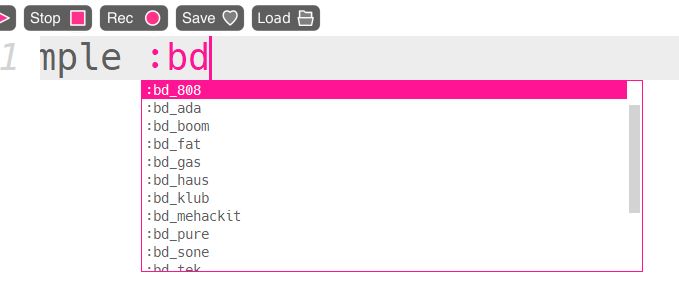In this activity, we will create a simple electronic music track using the Sonic Pi programming environment.
1. Setup
If you are using a Raspian-based computer (PC or Raspberry Pi), you should already have Sonic Pi installed on the computer.
If you need to download Sonic Pi, go to https://sonic-pi.net/ and choose the correct version to download.
2. First Sounds
Sonic Pi is a programming language designed to play electronic music. It runs within an Integrated Development Environment that lets you type code and run it with a few key presses.
When you open Sonic Pi, you should see something like this:
 .
.
You will write your code on the left. You can run and stop your code using the menu buttons, or by using key shortcuts (Alt-R to run, Alt-S to stop).
To test this out, we’ll play a drum sample. Write the following code and run it:
sample :bd_haus
When you run this code, you should hear a bass drum sound. It will only play once, so if you want to hear it again, you will need to run the program again.
Try some different drum sounds. If you start typing sample :bd then you should see an autocomplete menu with some other examples.
 Try changing the sample and run the program again.
Try changing the sample and run the program again.
3. Loops
The most interesting part of Sonic Pi is the ability to create live loops that will keep playing until they are stopped. Delete the code you have, and replace it with the following:
use_bpm 60
live_loop :kick do
sample :bd_haus, rate: 1
sleep 0.5
end
We set the bpm (beats per minute) to 60, which means we get one beat every second. We then create a loop called kick that plays our sample. It then sleeps for half a beat, which means we get two kick drum samples played per second.
Try changing the rate and sleep values to see what happens.
4. Drum beat
A typical drum beat has a kick drum, snare drum and hi-hat cymbal. We’ll add these in. Change your kick drum loop so it looks the same as in the previous section, then add the following code for the snare and hi-hat:
live_loop :snare do
sleep 0.5
sample :sn_dolf
sleep 0.5
end
live_loop :hihat do
sample :drum_cymbal_closed
sleep 0.25
end
5. Bass
So far we have just played samples of drums and cymbals. Now we will add in an electronic instrument called a Synthesizer to make a nice bass sound. We will only make it play one note. Add the following code to your current program:
live_loop :bass do
use_synth :prophet
play :E1, release: 3
sleep 2
end
Our instrument is an emulation of a famous synthesizer called the Prophet-5. We make it play an E1 note. We then sleep for two beats. Try changing the release value to see what happens.
6. Arpeggios
This isn’t a very interesting song so far, so we’ll add in some more synthesizer sounds that are playing random beep sounds. To make things more interesting, we’ll play random notes from a music scale (E minor).
Add the following code to your program:
live_loop :bleep do
use_random_seed 123
4.times do |i|
16.times do
use_synth :beep
play chord(:E3, :minor).choose, attack: 0, release: 0.1, cutoff: rrand_i(50, 90) + i * 10
sleep 0.125
end
end
end
Try changing the random_seed number and see what happens.
7. Chords
To finish our program, we’ll play some chords from the same E minor scale that we used earlier. Add the following code to your program:
live_loop :chords do
use_synth :blade
[1, 3, 6, 4].each do |d|
(range -2, 2).each do |i|
play_chord (chord_degree d, :e, :minor, 3, invert: i)
sleep 2
end
end
end
This code is quite complicated, but it:
- Uses the
bladesynth sound - Plays through the 1st, 3rd, 6th and 4th chords in the E minor scale in turn (Em, G, C, Am)
- For each chord, it plays four different inversions, moving up in pitch with each one.
Challenges
- Try changing each sample or synth sound
- Try changing the
attack,releaseor other values of each sound - Try adding effects (FX) to the sounds. You can click the Help menu button to see how to do this, and many other capabilities of Sonic Pi.
- Try live coding an entire song! As an example, you could watch the creator of Sonic Pi here: https://youtu.be/G1m0aX9Lpts
Full code listing
use_bpm 60
live_loop :kick do
sample :bd_haus, rate: 1
sleep 0.5
end
live_loop :snare do
sleep 0.5
sample :sn_dolf
sleep 0.5
end
live_loop :hihat do
sample :drum_cymbal_closed
sleep 0.25
end
live_loop :bass do
use_synth :prophet
play :E1, release: 3
sleep 2
end
live_loop :bleep do
use_random_seed 123
4.times do |i|
16.times do
use_synth :beep
play chord(:E3, :minor).choose, attack: 0, release: 0.1, cutoff: rrand_i(50, 90) + i * 10
sleep 0.125
end
end
end
live_loop :chords do
use_synth :blade
[1, 3, 6, 4].each do |d|
(range -2, 2).each do |i|
play_chord (chord_degree d, :e, :minor, 3, invert: i)
sleep 2
end
end
end